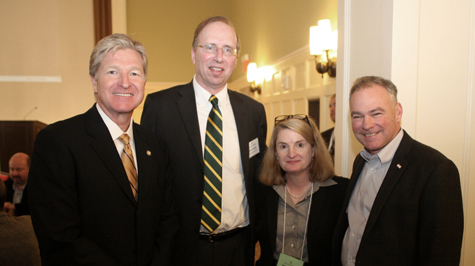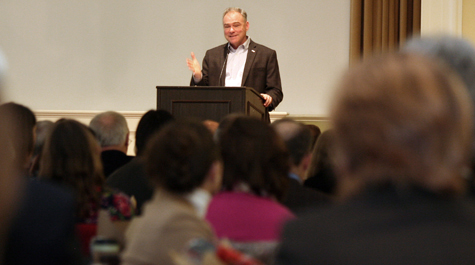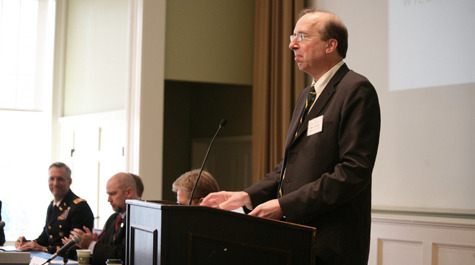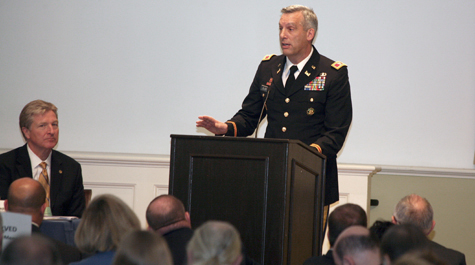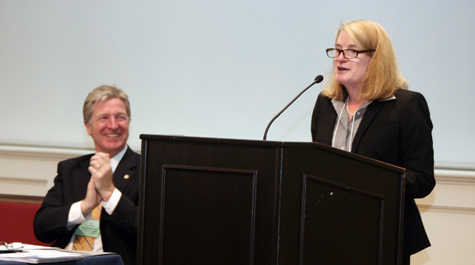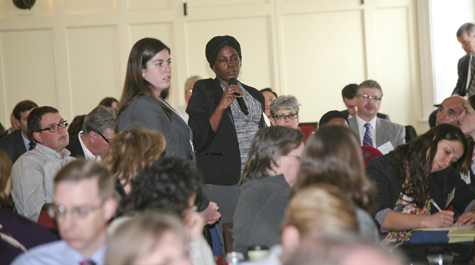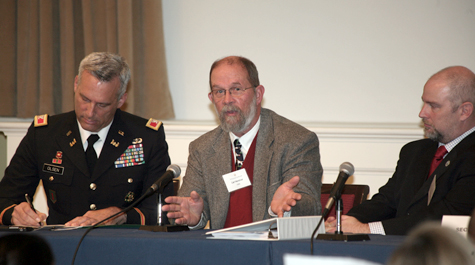Tim Kaine provides keynote at William & Mary Coastal Policy Conference
For U.S. Sen. Tim Kaine of Virginia, rising oceans and other climate issues are not just about predictions of what might or might not happen tomorrow.
“When you’re seeing it today, it’s a bit different,” he said. “And in Virginia we are seeing it today; we’re seeing the effects of sea level rise in Hampton Roads in a most dramatic way.”
Kaine made this observation as keynote speaker at a Dec. 5 conference, “Adaptive Planning for Flooding and Coastal Change in Virginia: Next Steps for the Commonwealth.”
Hosted by William & Mary Law School’s Virginia Coastal Policy Clinic (VCPC) and the Center for Coastal Resources Management (CCRM) at the Virginia Institute of Marine Science (VIMS), the conference brought together national, state, and local experts and leaders to discuss actions being taken to adapt to flooding and coastal change, and highlight key legal and policy matters confronting both the public and private sectors.
Speaking to more than 240 attendees who filled the spacious Brinkley Commons at William & Mary’s Raymond A. Mason School of Business, Kaine said it is important that public officials acknowledge their weaknesses as well as strengths, and rely on good science.
“I’m not a scientist, but I do listen to scientists, and I do believe that human activity is contributing to climate change,” Kaine said. “That poses very significant challenges to us, and we have to deal with them the right way, not the wrong way.”
By “right way,” Kaine meant taking a careful, measured approach to matters.
“We’re not going to deny the science, but if we try to tackle the problem the wrong way, we could do a lot of harm to our economy and to the standard of living we are proud to have in Virginia,” he said. “It’s about balance, as are most things in life.”
Kaine said that under current model projections, Hampton Boulevard, the main road to Navy Station Norfolk--the largest concentration of naval power in the world--is likely to be underwater about three hours a day by 2040. And that’s just on days with normal tidal action.
“This is one of the things that keeps me up at night,” Kaine admitted.
There are also huge storm surges that periodically threaten the region. Kaine said that Hurricanes Sandy and Katrina could easily have landed in Hampton Roads, and a similar storm will hit the region one day. He said leaders must be proactive with resiliency planning and build a set of communication and transportation strategies to mitigate the damage of these storms and challenges when they occur.
Kaine said that being proactive about resiliency involves targeted spending and innovation.
“You’re more able to do it right if you have a good brain pool, and that’s where Virginia excels because of our universities and our research institutions like VIMS,” he said. “Our resources aren’t infinite, but we do have a good brain pool to do it right.”
Kaine added that the regional work being done in Hampton Roads between state, local, and federal government and other organizations will not just benefit Hampton Roads; it could be piloted as a model for the nation in terms of cooperation on resilience strategies.
And that goes for slowing climate change as well. Kaine said the nation has to be “cleaner tomorrow than today,” which doesn’t mean pulling the economy’s emergency brake, but rather becoming incrementally cleaner over time.
Among several examples of success, Kaine cited how the U.S. has lowered carbon emissions and added wind power to the power grid. He mentioned Virginia being particularly serious about carbon emissions by promoting safe nuclear power.
“We will develop technology the rest of the world will want to buy if we embrace new opportunities,” he said.
Although he admits to staying up at night worrying about coastal flooding and climate change in Virginia, Kaine remains optimistic that the region’s leaders are up to the challenge.
“There’s no place that has a talent pool better than Virginia,” he said.
That pool was reflected in the makeup of Virginia’s Climate Change and Resiliency Update Commission, which held its second meeting at the conference. With leadership from Virginia’s Secretary of Natural Resources Molly Ward J.D. ’87 and Secretary of Public Safety and Homeland Security Brian Moran, the Commission includes nationally recognized scientists and academics as well as business and NGO leaders from across the Commonwealth.
At the Commission’s meeting, Secretary Ward announced the Governor’s appointment of Secretary Moran as Virginia’s first Chief Resiliency Officer. Secretary Moran will serve as the central coordinator for state planning and response to climate change impacts. In addition the Commission announced the creation of several work groups, one of which will focus on state legal authorities and limitations. The Commission asked the Virginia Coastal Policy Clinic to lead the work of the Commission on this issue.
Other discussion topics at the day-long forum included the National Flood Insurance Program's Community Rating System, Regional Adaptation Collaboration, Social Vulnerability in Hampton Roads, and Market and Private Sector Driven Adaptation. The event also saw the second meeting of Virginia Governor Terry McAuliffe’s Climate Change and Resiliency Update Commission.
“For the second year in a row, William & Mary has filled a responsibility to the citizens of the Commonwealth by hosting a forum that has yielded significant forward movement in Virginia’s ability to respond to the unprecedented changes that challenge our coastal resources and coastal communities,” noted Roy A. Hoagland, director of the Coastal Clinic. “As Virginia continues to be a leader in adapting to our changing climate, the clinic will continue to serve as an advisor to the state and its local partners on the legal and policy matters that continue to arise in this arena.”
 Skip to main content
Skip to main content

